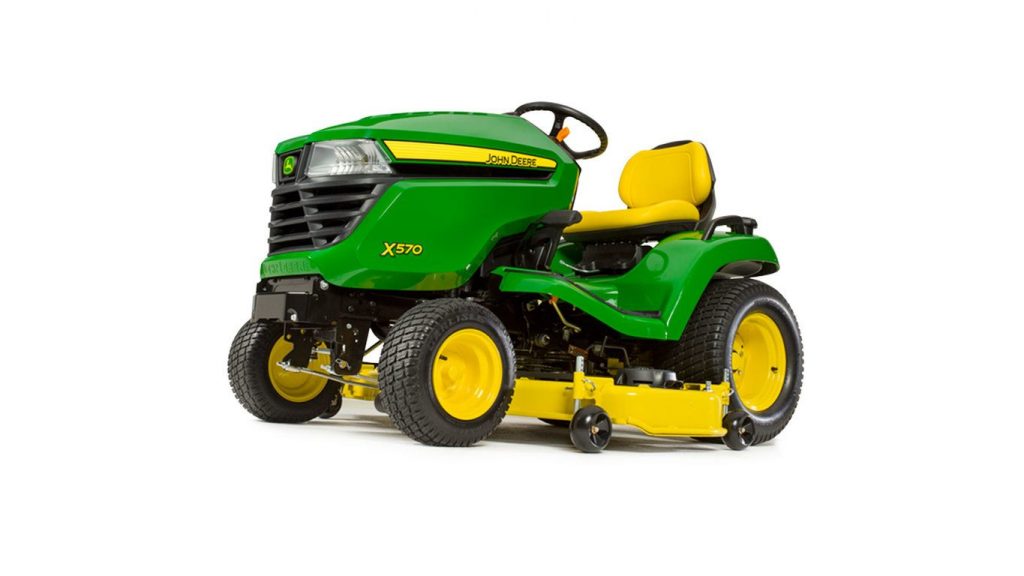- November 28, 2018
- No Comment
Top 3 John Deere Mowers & Their Prices

John Deere mowers are renowned for their high performance and precision cuts. Deciding which ride-on mower (aka ‘riding mower’) is right depends on your needs.
To make this process easier, we went straight to Brad Davis, National Sales Manager for Chesterfield Australia, to tell us about their top 3 best-selling John Deere ride-on mowers with prices.
- Entry-level John Deere E110 costs approx $3,600
- Mid John Deere X350 costs approx $5,600
- Top-range John Deere X570 costs approx $10,500
Find John Deere mowers for sale here.
A little about John Deere mowers
John Deere is the industry leader in all things farming machinery, including mowers. Not only do they manufacture your standard ride-on mowers, but also commercial mowers and golf mowers. When it comes to manicuring lawns, John Deere has a machine to do it. In general, their mowers offer precision, intelligent design, durability and performance.
To give you an idea of cost, we have gathered average prices* for buying brand new. The mowers featured in this article are relatively new to the market, as such there’s no one selling used models yet (good sign? We think so!).
Now that’s settled, let’s get to the top 3 John Deere mowers incl prices. We’ve listed these mowers by price*, from lowest to highest.
1. John Deere E110 Mower: Entry Level

The 100 series are John Deere’s most affordable ride-on lawnmowers. The E110 may be the second-smallest ride-on in the 100 series, but its performance will surprise you. Compact yet powerful, this lawn mower can mow up to 8000 m2. Operating the E110 is super easy thanks to its two-pedal hydrostatic transmission and offers a 42-inch cut.
“The 110 is definitely our biggest seller in the entry-level range.”
—Brad Davis, Chesterfield Australia
Some Standout Features of the E110 John Deere Ride-On Mower:
- Fast start thanks to its electronic ignition
- Prolonged engine life
- Anti-vibration system
- Cruise control option maintains mower’s speed
- Seat springs provide a smoother ride
New E110 John Deere mower price: approx. $3,600
2. John Deere X350 Mower: Mid Range

When you need to go a step up, the John Deere X300 series is ideal. Steering is effortless and with Twin Touch foot pedals, this machine helps you make light work of mowing large plots. The X350 is equipped with the new Accel Deep deck, which is specially shaped to increase airflow for more precise cuts (especially at faster speeds). Mow up to 1.4 ha without breaking a sweat!
A Quick Overview Of The X350:
Disclaimer: This video showcases an overseas model. Configurations may differ from the Australian model.
Some Standout Features Of The John Deere X350:
- 18.5 hp engine with cast-iron cylinder liners
- John Deere iTorque power system
- Exclusive hood design that provides superior lugging ability
- Heavy-duty welded steel frame
- Easy steering
New X350 John Deere mower price: approx. $5,600
3. John Deere X570 Mower: Top Range

Now we’re talking! Getting to the more heavy-duty jobs, the X500 series is ideal for those large stretches of land with obstacles such as tree roots, garden beds, etc. The X570 makes multi-terrain mowing a breeze. With a wider cutting deck than the previous mowers above, at 48 inches this ride-on mower will help you mow up to 1.4 ha faster.
A Quick Look At The X570:
Disclaimer: This video showcases an overseas model. Configurations may differ from the Australian model.
Some Standout Features Of The John Deere X570:
- 24 hp engine
- Larger cutting deck is stamped steel, deep, and has a flat-top to deliver excellent cut quality
- Optional MulchControl attachment
- Mower deck is suspended from the vehicle for a level cut
- Exact adjust ports make precise desk adjustments easy
New X570 John Deere mower price: approx. $10,500
You can see why John Deere are industry leaders in all things farm machinery. Their designs are smart, the machines offer high performance, and they are built to last.
Do you agree with this article? Let us know in the comment below. Find used John Deere mowers for sale here or check your finance options.
*Prices are based on Machines4U listing data provided by sellers/advertisers and are an approximation only. Data is correct up to and at time of publishing. Prices may change and need to be verified with individual sellers.




